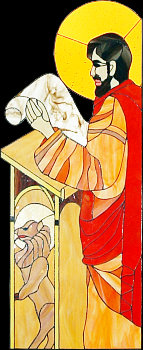
Man had learned how to make glass long before Christ was born. The Egyptians were able to manufacture glass vessels and beads as early as 4000 years B.C. They could also cover earthenware with glass. However, it seems that the Romans were the first to obtain glass panes big enough to glaze windows or make mirrors.
Most people see only the sacral aspect of stained glass. Indeed, stained glass in churches served the purpose of educating believers, often illiterate. Stained glass windows illustrated the Bible and were used only in places of worship.
The 20th century brought a big change as regards the use of decorative character of stained glass. This type of glazing became popular in private houses, especially in Victorian England where an increase in people's income made the housing industry booming.
Stained glass entered private houses in America thanks to designs and technical innovations introduced by Louis Comfor Tiffany. He replaced the heavy lead came with a new technique that consisted in wrapping the edge of glass with a thin layer of copper foil. Once wrapped, he joined the adjacent copper surfaces soldering them on top and bottom. It paved the way for patterns both finely formed and complex. Tiffany carried out experiments that resulted in an improved method of casting the marble-like opalescent glass. This type of glass has become a touchstone for all craftsmen working with glass. One can admire the best examples of Tiffany's bold and spectacular use of colour and pattern in windows of his mansion in Oyster Bay (see picture).
Stained glass like any discipline of art has got a unique style that belongs to the very days when it came into being.

The same is true of Art Noveau which developed in different ways and scopes in various countries. Paris, London or Brussels are often considered the cradle of Art Noveau. Indeed, these are the cities where the basic principles of Art Noveau were formulated and from where it radiated worldwide. However, these European cities have to accept the truth that for the first time in the history of art an American city, Chicago, was one of the places where artists created works of art that were ahead of their time, pointing to the future characteristics of Art Noveau.
The style met with favourable conditions in Cracow, which soon became the centre of Art Noveau in Poland. Furthermore, thanks to the interest in stained glass shared by such great masters as Wyspianski and Mehoffer, the style not only developed rapidly but gained unique features as well.
One may come across stained glass in various places: modern shopping centers, historic churches and cathedrals, city halls, Victorian tenement houses, museums, restaurants, etc. It is enough to take up some interest in stained glass in order to acknowledge that this seemingly redundant decorative element is very often present in our surroundings, making these places even more charming.
The last decade witnessed growing interest in stained glass as elements of architectural and interior design. The successful revival of stained glass owes a lot to the fact that more people live on a higher income and further innovations have been developed in the field of stained glass making. Several economic and technical factors explain why stained glass started to be used in triple-glazed insulated units (as the internal panel); they include the introduction of standardized PVC joinery as well as the need for better heat and acoustic insulation. The triple-glazed insulated units let their users benefit from all the unquestionable advantages of double or triple glazing and at the same time offer them decorative qualities of stained glass.
This innovation has made stained glass a very popular or even indispensable element in front doors, windows in living rooms and salons, passages and staircases of buildings being constructed nowadays. On the other hand, it allows for modernization of stained glass in places of worship as regards improved heat insulation and their protection against unfavourable weather conditions.
|